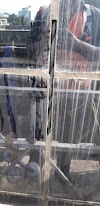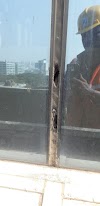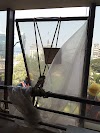In the entire Façade, though only glass is visible from outside (and sometimes aluminum), it cannot stand there without the presence of some other materials. Here, we will discuss all major materials that are important from a fabrication and installation point of view. In short, glass is supported by an aluminum structure with silicone or held with an EPDM gasket. These panels are joined with screws made of stainless steel. The whole structure is supported by aluminum or mild steel brackets. These brackets are fixed to the RCC with stainless steel anchor fasteners. But why are only these materials used? We will get the answer to this question in the following blog post.
Materials used in the Façade
A façade is an assembly of different materials having some common properties suitable for construction and some unique properties that different materials possess. Together, they give a strong and aesthetically appealing product. The life of a Façade depends on the durability of each product. All parts in such an assembly must be compatible with each other. There are certain reasons why such material is selected to be a part of the assembly of the Façade.
 |
| Typical Plan and section detail showing material in Façade |
Why Mild Steel?
Though Façade Panels are mainly consisting of Aluminium and Glass, these panels are connected to civil structures with MS brackets. Most of the time, these brackets are also made with Aluminium serrated brackets. MS sections are also used as inserts in Aluminium Sections when the section available in the market is not strong enough. Also, in construction, when there is no civil construction behind the Façade MS structure is installed. Brackets in this case will be welded to such an MS structure.
The following are the reasons why MS steel is used in Façade Construction.
- High tensile strength and malleability.
- can be joined/welded easily,
- It can support heavy weights.
- As required in building construction, mild steel is not easily susceptible to damage
- widely and cheaply available compared to other ductile metals
- The coefficient of Thermal expansion of concrete and mild steel is almost equal. An Equal thermal coefficient will ensure the bond strength during thermal expansion, thus preventing bond failure.
- Hot-dip galvanizing to Mild steel ensures corrosion protection & gives brackets a longer lifespan, and it is low-cost, sustainable, and durable.
- Hot-dip galvanizing to Mild steel adds resistance to rain, extreme temperatures, and the general effects of weathering.
 |
| Hot Dip Galvanized MS Bracket |
Why Aluminium?
Aluminium is the major component in Façade that holds the glass and same time looks beautiful from the inside than Mild steel. Its following properties are perfectly suitable for use in Façade.
- Lightweight material. Its density is 2700 Kg/m3
- Resistant to weather and corrosion
- Easy to bend and fabricate
- Easy to recycle without losing quality, with very little energy to recycle
- Get powder-coated/anodized in different shades and patterns.
- It is The surface without coating also appears better than steel
- Available in various shapes, sizes, and thicknesses
- Can be extruded in customized cross-sections
- Pipes can be bent in a Curve
- Compatible with other materials in Façade, including Silicone, Glazing Tape
Why Stainless Steel Hardware?
Products that cannot possible to be made with Aluminium with sufficient strength are made with Stainless steel. Hardware including Handles, Butt or Friction Hinges, Restrictor Arm, and parts of Locks are made with SS. SS screw having a Grade of 304 or 316 are generally suggested. SS316 grade screws are highly recommended where screws are visible from outside since they don’t rust but they are costlier than 304 grades.
- improved corrosion resistance,
- higher tensile strength,
- Improved ductility/malleability.
- Its corrosion resistance.
- It is an easy and cost-effective metal to clean and maintain.
- Stainless steel is preferred in clean and sterile environments as it is simple to clean and does not easily corrode.
- Stainless steel self-healing corrosion resistance provides an affordable and lower-maintenance alternative to treated or plated fasteners made from other materials.
- SS 316 grade contains molybdenum that drastically enhances corrosion resistance, especially for more saline or chloride-exposed environments.
 |
| Typical one of the SS fitting in the Spider Glazing Glass Façade |
Why Silicone?
Silicone has played a crucial role in the evolution of Façade. Earlier, the edge of the Glass was placed over the surface of the Aluminum and it was held by an Aluminium pressure plate by screws, and that plate was covered by an aluminum Cap with Snap-fit. This affected the visual appearance of the Façade since all glasses were mandatorily having aluminum boundaries visible from the outside. Structural silicone has eliminated the use of such a system and allowed architects to think about the look of the building without Aluminium strips visible from the outside. In addition, it has allowed the making of double/triple glass units.
- Generally, chemically non-reactive, resistant to attack by most chemicals.
- Naturally low thermal conductivity, i.e., 1 W/Sq., Non-toxic when used appropriately
- Highly water-repellent & Natural insulator, Electrical Conductivity is zero
- Excellent Sealing Ability, Excellent adhesion to smooth surfaces; Extremely resistant to degradation by both radiation and oxidation
- Physical and mechanical properties remain stable across a wide temperature range
- Easily extrudes in any weather and cures at ambient temperature by reaction with moisture in the air to form a durable, flexible silicone rubber seal.
- Structure Silicone cures to form an extremely tough elastomeric rubber, ensuring a durable, flexible, watertight bond. Excellent weather ability and high resistance to ultraviolet radiation, heat and humidity, ozone, and temperature extremes
- One of the types, i.e., Fire sealant, is filled between the flashing of Rockwool and the slab to restrict the smoke from flowing to the upper floor.
| Grey weather Silicone between Aluminium sheet and Glass |
Why Glasswool / Rockwool
When double-glazed units are used in the Vision area are more efficient than normal single-glazed windows.. However, it also costs more. The same DGU can be used in front of the slab, but it is not recommended since no one is going to have the same benefit as in the vision area. Here single glass with Glasswool is installed to get the same effect at a lower cost. Glasswool is placed in powder powder-coated GI sheet tray. A coated sheet or thermal sheet is placed over Glasswool towards the glass so that the Glasswool is not visible from the outside. Hence, such an assembly is installed away from the inner surface of the glass. Glasswool imparts the following properties.
- a thermal insulation material consisting of intertwined and flexible glass fibers, which causes it to "package" air, resulting in a low density
- good molding, small bulk density, low thermal conductivity, thermal insulation, good sound absorption performance, Features of corrosion resistance
- Glass wool products can be used for 20-30 years, without the need to change.
- It has good high-temperature thermal stability, durability, and resistance to high-temperature shrinkage;
- Mineral wool is an excellent insulation because it can retain a lot of air
- Mineral wool is resistant to water, so it doesn't get damp and provides good growing conditions for fungi, mold, mildew, or other bacterial growth.
- Glass wool can get damp and promote the growth of fungi, mildew, and rot, causing its insulating properties to be severely reduced. Hence, GI sheets surrounded with sealant are used to reduce cost.
- Rockwool restricts the smoke flowing from the lower floor to the upper floor and restricts the heat flowing from the lower floor. This heat and smoke may cause Fire on the upper floor due to convention and radiation. It has more density than Glasswool, placed at the gap between the Façade and Slab in an enclosure made with GI sheet.
 |
| Glasswool / Rockwool |
Why EPDM Gaskets?
EPDM rubber (Ethylene Propylene Diene Monomer Rubber) is a type of synthetic rubber used in many applications. Like most rubbers, EPDM is always mixed with fillers such as carbon black and/or calcium carbonate, and plasticizers such as paraffin oil, and has useful rubber-like properties only when cured. EPDM is a highly valuable material in the construction industry (mainly aluminum manufacturing segment, curtain wall industry, UPVC window and door segment – EPDM extruded rubber profiles, EPDM expansion joint profiles segment), accounting for 40% to 45% of EPDM consumption in the world. Within this category, curtain wall systems are the largest application (40%).
- EPDM rubber products have excellent UV and ozone resistance,
- Long life and elasticity.
- Strong weather resistance.
- It functions in an external area where it is either continuously or occasionally exposed to the elements.
- Able to withstand Sunlight, Temperature, Ozone & UV, and Inclement Weather Conditions.
- Able to withstand humidity, dew, rain, snow, frost, or hail.
- EPDM is compatible with a wide range of other materials and demonstrates exceptional weather resistance.
- Along with being a Strong chemical resistant to a variety of chemicals, diluted acids and alkalis, and heat and weather, EPDM can withstand the degrading effects of ozone, oxygen, heat, and weather.
- EPDM applications require little to no maintenance compared to the other elastomers in the market.
- When long-term weather resistance is needed, such as for waterproofing flat roofs of office buildings and homes, it is typically utilized in waterproofing.
- It is so tough and resilient that it can withstand numerous temperature fluctuations, tears, and abrasions.
- High durability: The thickest and most durable EPDM membranes can last over 40 years. The membrane rarely rips or tears and is durable, yet easy to repair and maintain.
 |
| EPDM Gaskets |
Why Glass?
Director,
Landscape Wall Systems
9819 663 630












0 Comments